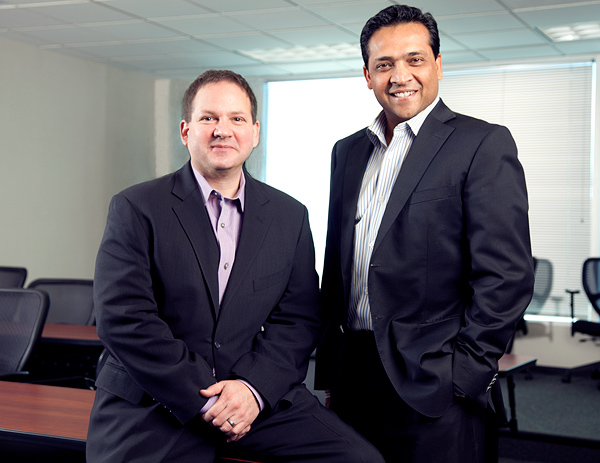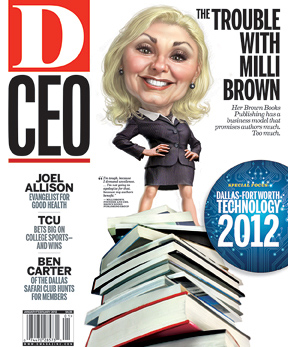SM: John has led by example, too. The employees feel that he is taking flights, writing code, fixing code—ultimately he led by example. People would try to be what John is.

JM: CA is not in our space, really. They are adjacent to us on both sides, which is kind of nice, but they’re not really in our space. We had partnerships with two other companies, IBM and HP, that were very much in our space. It was like, ‘Keep your friends close, but your enemies closer,’ and we were both doing that to each other.
So, there were some natural synergies to talk to the CA guys, and that turned into some interest early on—a couple of years ago. We had a tough decision to make at the beginning of [2011]. We had stepped into the right revenue trajectory; we had been highly, highly profitable—35-40 percent margins. And so the question was, ‘Should we do this another 18 months to two years, and then go public?’ Or, ‘Should we recapitalize and do private equity?’ Or, ‘Should we get acquired?’ But CA was in the mix from the beginning.
Another company that was a partner of ours actually triggered the process that we wound up going through, because they were considering a turnkey [project] with us. Then a private equity firm had seen our financial results and it wanted in, too. So, there were a lot of interesting pros and cons to each option. In the end we decided that being acquired was the best thing for us, for our employees, and for the product, to reduce a lot of risk that we thought we saw entering the picture.
Shridhar, could you briefly explain the other alternatives?
SM: Like John said, we were doing exceptionally well. We had talked to lots of investment bankers who told me that we could have gone public as early as next calendar year. So we started exploring the options. There were four strategic companies and four private equity companies [that were interested], and these were the Who’s Who on both sides. The private equity people knew that we were highly profitable, but we wanted to see how the process would shape up for us.
Then as we started getting into more detailed discussions, that’s when we realized the best path for us would be the merger path, because you get an existing sales force—which was the No. 1 thing that we needed. The product itself was ready to go, every company in the world could use it, but we didn’t have a global entity. We had no entity in many of the European countries, no entity in Australia, nothing in India. So, why set all that stuff up? We wanted to get to market really, really fast, and get the 2,000 sales reps that came along with CA.
How big was your own sales force?
SM: Twenty to 30.
How transparent were you with your team while you were going through the process?
SM: To be honest we were not very transparent. If the word starts getting around, people start behaving very, very differently. So we tried to keep this very close to just a few members of the management team.
So now iTKO will operate as a separate unit within CA, and you’ll keep your own people and call your own shots here in Plano?
SM: Yes. No person has been moved from our organization to any other organization. We’ve had zero attrition in this whole process. Eventually, obviously, some of the back-end functions will get eliminated, but that’s really the only thing. Other than that—sales, development, services, support —everything stays.
Was it important in considering the acquisition to keep the company intact?
SM: Yes. We’d built a really good team. We’d learned over the years that every company has its own culture. CA ‘analyzed’ us and said, ‘iTKO is where we want to go as a company. We want to adopt their culture.’
JM: It was very important. CA is a very clean integration for us. Our software doesn’t have to get chopped into bits.
When a deal like this happens, are the employees richly rewarded?
JM: We paid the market [rate salaries], especially for the tech guys, because we had an extremely high bar. We didn’t let anybody in who wasn’t exceptional to begin with. In fact, the joke was: If they weren’t quite at our bar, we had a whole list of competitor companies we would tell them to go apply to. But the way we incented was that, on an annual basis most of the time, we rewarded with options. They didn’t get a bunch of options when they started; they got them at each fiscal year as they contributed in a meaningful way. And so, our very best guys are near-millionaires; they did really, really well. And the guy who was sitting beside them who did a great job—you’ve got to do a great job to exist at iTKO—they did all right.
What was the first thing you bought after the deal closed?
SM: I bought a Maserati convertible. [Applause.]
JM: I bought property and built a house for my mom. [Applause.]
How has this whole journey affected you personally?
SM: When I left i2, I’d been there for 11 years. I’d seen it go from a 50-person company to a 6,000-person company, from $11 million to $1.1 billion in revenue, all in six years—and then all the way down to $300 million in the next five years. But then when I decided to leave i2 and go into business with John, I had several other opportunities that I could have taken up, but they would have been the same-old same-old—what I’d already been doing for 11 years. So, this seemed like a very exciting opportunity, and I trusted John and Ruston. And there was this culture here of work hard, play hard. We work just as hard as anybody else, but then, when we go to party, we party. We’ve had a lot of fun through the years.
What kind of lessons are there in your experience that other entrepreneurs could learn from?
JM: Frankly, the relationship between Shridhar and I could have tanked this thing just like that, at any point. He did a miraculous thing in being able to take something that was not his vision and take it as his own—build it, take it to market, be as passionate about it as the guy who came up with it, even though half the time he was not really sure what he was saying early on. [Laughter.] But now he is, by the way, because he’s really done the homework. He and I always use the phrase that we’re not going to let any disagreement we have be heard ‘in front of the kids.’ Because the last thing we wanted was any of the folks who were supposed to be trusting us to hear us out of sync in any way, because that would be a really, really damaging thing. I didn’t want to be CEO, but I didn’t want a challenge, right? I didn’t want to be fighting with the guy that I asked to be my boss. So that was a big one.
Another [lesson] was: We just had to make sure the product worked. I can’t believe how many small companies produce software that doesn’t actually work at the end of the day. There’s an order of operations to this stuff, right? And it starts with a really good idea, but in between that and selling it is something that you can actually use. And maybe I actually spent too much time making sure it worked, but that made me sleep very comfortably at night, knowing that this wasn’t going to all crumble down at some point. We knew there
was intrinsic value.
And then the third [lesson] we talked about already, but, [it’s important to have] really exceptional people that are your people. When you outsource too much, they don’t have the loyalty. I assure you that at 11 p.m., guys that have already made a million bucks working here will be up working on something and trying to make sure that the customer’s happy or trying to make sure that they make a build in time or trying to make sure they get the deal to close. And that’s because they’re ours. They’re believers. If there are too many that aren’t, it isn’t going to work.
You mentioned your smooth relationship with Shridhar. Surely, though, you guys must have had big disagreements over the years?
SM: I know them all! [Laughter.] To be honest, I don’t think there’s been a single day in our six years together where we walked out of the office over a disagreement and didn’t talk to each other for a day or two. That just didn’t happen. There were disagreements on strategy, sure—about wanting to do this or that. But the good news is that both of us are very, very comfortable listening to each other’s points of view and then making a decision. Strategy decisions, hiring decisions—we made them jointly.
Have you two talked about when either one of you might leave, what the other would do—and whether you might want to do something else together in the future?
SM: We both feel we’ll be there for a couple of years, maybe even longer. We’ve decided to do this; we don’t want to just say, ‘See you,’ and walk out of there. One of the drivers for selling the business was to make it a billion-dollar company. So we want to see that vision come true—at least significantly.
JM: That’s your story, right? [Laughter.] Mine’s very much the same. Frankly, I feel a very large debt I’ve gotta pay to all those guys that threw in with us in ’03, ’04, ’05, ’06, ’07, when we were not profitable. In fact we hired five people, sight unseen, [very early on]. I am obligated to stay there and make them extremely successful. And I want to see what we build dominate its market. It’s dominating certain individual segments right now, but it’s got a lot of room to grow. So, we’re not in any mood to slow things down. We’ll probably think about that in a couple of years. But by then we will have captured the entire market, at least the top end of the market. Then we’ll leave it to others to distribute it down.






